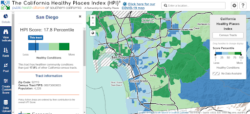
By Vayunamu Bawa, Contributing Writer
Social determinants that contribute to health disparities, particularly in the Black community, include race/ethnicity, gender, income, health literacy, social status, food and housing security, education, employment, transportation, support networks, and physical environments. To help the public better understand the factors and impacts of health disparities in San Diego County and how they impact communities of color, the MolinaCares Accord hosted a virtual panel last Thursday, September 30. The discussion, entitled “Addressing Social Determinants of Health and Access to Care Against the Backdrop of a Pandemic”, was hosted by a panel of local public health experts who shed light on County successes and addressed the urgent need for organizations and County entities to address persistent health disparities that negatively impact the wellbeing of San Diego’s African American population.
The panel of experts included San Diego County Public Health Officer Dr. Wilma Wooten; President and CEO of the Neighborhood House Association Rudolph A. Johnson; and Executive Director of the San Diego Organizing Project Dinora Reyna Gutierrez. Feeding America’s Chief Government Relations Officer Vince Hall moderated the discussion. Hall, along with Supervisor Nathan Fletcher, who made opening remarks, discussed the inequities exacerbated by the pandemic through a local lens and the need for cross-sector collaboration to ensure communities have access to quality care.
A Pew Research Center analysis of the 2000 census and 2018 Census Bureau population estimates named San Diego County as a “majority, minority county” in 2000. With people of color outnumbering non-Hispanic whites, these health disparities significantly shape San Diego County’s health outcomes.
“We have to make changes in these conditions where people were born, where they grow, live, and age,” Dr. Wooten said.
The state of California developed a Healthy Places Index (HPI) which indicates community health conditions based on the social determinants that can affect community health. The data is sorted by zip code into one of four quartiles. San Diego County has used the information to inform a “Vaccine Equity Metric” which gauges priority for vaccine distribution. Dr. Wooten said the County has been successful in getting the least healthy quartile vaccinated.
Gutierrez spoke on the multi-racial, multi-generational, and multi-faith nature of those served by the San Diego Organizing Project. The Project, Guiterrez said, has worked with trusted clergy and community leaders to bring testing and vaccination to faith-based institutions since those are the places people feel safe.
However, a lot more needs to be done for the Black neighborhoods that make up the least healthy quartiles. The data demonstrated the need for better access to care above and beyond the COVID-19 pandemic.

Another area of disparity discussed was infants and pregnancy in the Black community. The Neighborhood House Association serves Black mothers, from their pregnancy to after-school programs for their children, through its Black Infant Health Program with the County. The California Department of Public Health Birth and Death Statistics show that African-American infants are nearly three times more likely to die during their first year of life, nearly 60% more likely to be born premature, and nearly two times more likely to be born with low birth weight compared to County infants overall.
“The families that we serve are some of the hardest families to reach in hard-to-reach communities, and the most vulnerable families when it comes to the social determinants of health,” said Neighborhood House Association CEO, Rudolph A. Johnson, who participated in the panel discussion. Programs like Head Start work to break the cycle by providing better conditions for low-income Black children through educational and social support.
Dr. Sayeed Khan, Chief Medical Officer for Molina Healthcare of California, spoke on linking families to the care they need and the need to focus on preventive care.
“Our children spend six to eight hours a day in school and that’s a prime opportunity to bring preventative services to them,” Khan said. Having healthcare coverage does not always translate to access to care, he said, and many residents may not know how to get coverage. Indeed, a 2021 study sponsored by the Johns Hopkins Primary Care Policy Center found that low-income minorities with poor health had 68% fewer odds of being insured than high-income Whites with good health.
Like the pivot to telehealth during the pandemic, innovation is needed when it comes to delivering care to vulnerable demographics outside the clinic and getting the right information to them where they are.
The San Diego Voice & Viewpoint’s coverage of local news in San Diego County is supported by the Ethnic Media Sustainability Initiative, a program created by California Black Media and Enthnic Media Services to support minority-owned-and-operated community newspapers across California.

